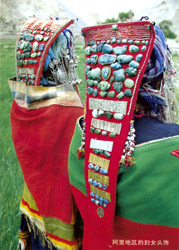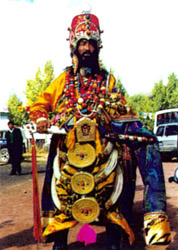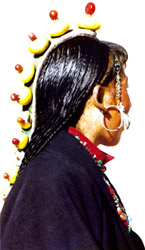Source: Tibet.cn
04-30-2008 20:22
One of the essential aesthetic points of the Tibetan dress art is its striking background colors to back the patterns or silver ornaments. The herders in Northern Tibet usually wear a white or brown robe. The farmers in the Tsang region like to use brilliant and eyes-catching colors for their dress, showcasing the optimistic and vigorous personalities of the Tibetan people. This backing effect of the striking background colors reminds us of another aesthetic point of the Tibetan dress aft – color area contrasting. Such contrasted color-pairs as red with black, white and black, red against blue, and yellow and purple, etc., are adventurously applied in their dress. For instance, the white tweed fabric robes are usually edged with wide black bands on cuffs, collar, and lower hem. Women’s hair is often dressed with silk or wool threads with such strikingly contrasted color-pairs as red and green, pink and sky-blue and so on.
 |
 |
| Warrior Dress in Khamba |
 |
| Lady’s Headware in Qamdo prefecture |
In addition, there is also a contrast between the lace patterns with thick and thin lines, etc. those are all further extensions of the aforesaid backing effect. Behind the striking contrast, there is another aesthetic point, i.e. the harmonization and consistency. Between the strikingly contrasted colorpairs, golden lines of different hues or other mitigating shades are smartly used as boundary transitions, giving a lively and consistent effect. The most obvious example is a kind of women's apron called a Bangdian. Some of them, with a color phase as a key shade, are patterned with such solid colors as red-violet, reddish-brown, blue-green, and so on, and some of them are patterned with groups of colors in an incrementally changing manner. Some of them are decorated with patterns of different shapes separating the color bands to activate the vision, really an ingenious design. The last but not the least aesthetic point is generously using treasures such as gold, silver, jade and pearls as ornaments. Symbolizing nobleness, luxury, sobriety and chasteness, gold and silver wares are used as the dress ornaments by people in many ethnic groups, including the Tibetan people. The backing effect principles of the Tibetan dress art are also reflected in the gold and silver ornaments, which have background patterns and principal patterns. The back-ground patterns are usually grass, clouds and waves. The different patterns are often embossed in three layers. Take the double-dragon embossed patterned silver ornament on a waist belt as an example. Its principal pattern, the double dragons, is on the top layer. The treasure pattern is on the second layer, and the cloud pattern is on the deepest, very well backing the subject.
Editor:Du Xiaodan
